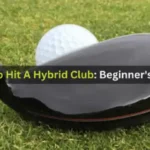Driving the golf ball with power and accuracy is a fundamental skill in the game of golf. Learning how to hit a driver effectively can significantly enhance your performance on the course. By following a few key steps and practicing consistently, you can improve your driver swing and see better results in your game. Let’s delve into the essential techniques to help you hit your driver with precision.
How to Hit a Driver in Golf (Step-by-Step)
Step 1: Understanding the Basics of the Driver Setup

To hit a driver successfully, Start by positioning the ball inside your front heel, ensuring that your spine is tilted away from the target. Align your feet, hips, and shoulders parallel to the target line to promote a straighter ball flight. Keeping your body in the correct position at address sets the foundation for a successful drive.
Step 2: Achieving the Correct Grip
The grip is crucial in determining the outcome of your shot. Place your lead hand at the top of the club with your thumb pointing down. Then, interlock or overlap your trailing hand beneath it. Ensure a firm grip without squeezing too tightly.
Step 3: Perfecting the Stance and Alignment

Align your feet, hips, and shoulders parallel to the target line. Distribute your weight evenly on both feet to maintain balance throughout the swing. Position the ball forward in your stance to promote an upward strike at impact.
Step 4: Mastering the Backswing
Initiate the backswing by turning your shoulders away from the target while retaining the angle between your lead arm and the club. Shift your weight to the back foot as you hinge your wrists to store power for the downswing.
Step 5: Executing the Downswing
Start the downswing by transferring your weight to the front foot while rotating your hips towards the target. Keep your lead arm straight to ensure a wide arc, generating maximum clubhead speed. Maintain a smooth transition for accuracy and distance.
Step 6: Impact and Follow-Through
At impact, focus on hitting the ball with a slight upswing to optimize launch and reduce backspin. Strike the ball with a square clubface to promote a straight flight path. Complete the swing with a high finish and balanced follow-through.
Common Mistakes to Avoid When Hitting a Driver in Golf
Golf is a sport that requires precision, skill, and practice. When it comes to hitting a driver, many golfers often make common mistakes that can hinder their performance on the course. In this guide, we will highlight some key errors to avoid when hitting a driver in golf.
Lack of Proper Setup and Alignment
One of the most common mistakes golfers make when hitting a driver is improper setup and alignment. It is crucial to ensure that your feet, hips, and shoulders are aligned parallel to the target line.
Additionally, your ball position should be slightly forward in your stance to promote an upward strike on the ball. By neglecting proper setup and alignment, you set yourself up for inconsistency and inaccuracy in your shots.
Gripping the Club Incorrectly
Another mistake to avoid when hitting a driver is gripping the club incorrectly. Your grip should be firm yet relaxed, with your hands working together as a single unit.
Avoid gripping the club too tightly, as this can restrict your swing and affect your clubhead speed. A proper grip allows for better control and power throughout your swing.
Over-swinging or Lack of Tempo
Finding the right balance in your swing is key to hitting successful drives. Many golfers make the mistake of over-swinging, thinking that more power equates to more distance.
However, over-swinging often leads to a loss of control and poor contact with the ball. On the other hand, swinging too slowly can also result in a lack of power. Focus on maintaining a smooth tempo throughout your swing for optimal results.
Incorrect Tee Height
The height of your tee can impact the trajectory and distance of your drive. A common mistake golfers make is using the wrong tee height when hitting a driver. Ideally, the bottom half of the ball should be above the top line of the driver at address.
Adjusting your tee height based on your swing and the desired ball flight can help optimize your launch angle and carry distance.
Poor Weight Distribution and Balance
Weight distribution and balance play a significant role in achieving a powerful and accurate drive. Some golfers make the mistake of swaying or leaning too far back or forward during their swing, leading to inconsistent ball striking.
Ensure that your weight is evenly distributed at setup and maintain your balance throughout the swing to generate maximum clubhead speed and maintain control.
Lack of Practice and Patience
One of the biggest mistakes golfers make when hitting a driver is a lack of practice and patience. Improving your driving skills takes time and dedication.
Regular practice sessions focused on technique, consistency, and course management are essential for honing your skills and becoming a better driver of the golf ball.
FAQS
Q: What is the correct tee height for hitting a driver?
A: The ideal tee height for a driver is generally when half the ball is above the top line of the driver at address.
Q: How should I grip the driver?
A: Use a grip that feels comfortable and allows you to control the club. The most common grips are the overlapping, interlocking, and ten-finger grips.
Q: How can I generate more power with my driver?
A: To generate power, focus on a smooth, controlled backswing, transferring your weight to your back foot, then shifting it forward as you swing through the ball.
Q: How can I improve my driver accuracy?
A: Practice proper alignment, grip, and swing technique. Also, consider taking lessons from a golf professional to refine your skills.
Q: Should I try to hit the ball as hard as possible with a driver?
A: No, it’s more important to focus on technique and timing. Trying to swing too hard can lead to a loss of control and consistency.







